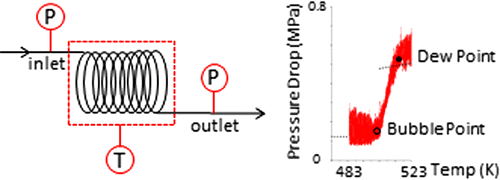当前位置:
X-MOL 学术
›
J. Chem. Eng. Data
›
论文详情
Our official English website, www.x-mol.net, welcomes your
feedback! (Note: you will need to create a separate account there.)
Pressure-Drop Method for Detecting Bubble and Dew Points of Multicomponent Mixtures at Temperatures of up to 573 K
Journal of Chemical & Engineering Data ( IF 2.0 ) Pub Date : 2018-02-16 00:00:00 , DOI: 10.1021/acs.jced.7b00755 Gurbuz Comak 1, 2 , Christopher Wiseall 1 , James G. Stevens 1 , Pilar Gomez 1 , Jie Ke 1 , Michael W. George 1, 3 , Martyn Poliakoff 1
Journal of Chemical & Engineering Data ( IF 2.0 ) Pub Date : 2018-02-16 00:00:00 , DOI: 10.1021/acs.jced.7b00755 Gurbuz Comak 1, 2 , Christopher Wiseall 1 , James G. Stevens 1 , Pilar Gomez 1 , Jie Ke 1 , Michael W. George 1, 3 , Martyn Poliakoff 1
Affiliation

|
Filled or empty tubular reactors have been at the heart of many chemical processes in academia and industry. Understanding the phase behavior in such reactors is essential to improving the conversion and selectivity of a given chemical transformation and to minimizing energy consumption. This study shows that the pressure-drop method is a simple and effective technique for measuring vapor–liquid phase equilibria at temperatures of up to 573 K. The basis of the pressure-drop method is flowing the fluid through a capillary with a relatively small inner diameter. The pressure drop between the inlet and outlet of the capillary depends on the phase state of the fluid (gas and/or vapor). In this article, pure propan-2-ol and the binary system propan-2-ol + water have been investigated to validate the method at high temperatures for these fluids. The binary system water + acetonitrile was then measured to demonstrate that the phase equilibrium of a thermally reactive mixture can also be determined by using the pressure-drop method. We have modeled the experimental pipeline pressure-drop results with the Process Systems Enterprise gPROMS ProcessBuilder 1.1.0 modeling environment using the Peng–Robinson equation of state and the superTRAPP algorithm for transport properties, and we find that the theoretical calculations are in good agreement with the experimental results.
中文翻译:

降压法在高达573 K的温度下检测多组分混合物的气泡和露点
填充或空管式反应器一直是学术界和工业界许多化学过程的核心。了解此类反应器中的相行为对于提高给定化学转化的转化率和选择性以及最大程度地降低能耗至关重要。这项研究表明,压降法是一种测量温度高达573 K时汽液相平衡的简单有效的技术。压降法的基础是使流体流经内部相对较小的毛细管。直径。毛细管的入口和出口之间的压降取决于流体(气体和/或蒸汽)的相态。在本文中,对纯丙-2-醇和二元体系丙-2-醇+水进行了研究,以验证这些流体在高温下的方法。然后测量二元体系水+乙腈,以证明热活性混合物的相平衡也可以通过使用压降法确定。我们已经使用Process Systems Enterprise对管道的实验压降结果进行了建模 使用Peng-Robinson状态方程和superTRAPP算法获得gPROMS ProcessBuilder 1.1.0建模环境的传输特性,我们发现理论计算与实验结果非常吻合。
更新日期:2018-02-16
中文翻译:

降压法在高达573 K的温度下检测多组分混合物的气泡和露点
填充或空管式反应器一直是学术界和工业界许多化学过程的核心。了解此类反应器中的相行为对于提高给定化学转化的转化率和选择性以及最大程度地降低能耗至关重要。这项研究表明,压降法是一种测量温度高达573 K时汽液相平衡的简单有效的技术。压降法的基础是使流体流经内部相对较小的毛细管。直径。毛细管的入口和出口之间的压降取决于流体(气体和/或蒸汽)的相态。在本文中,对纯丙-2-醇和二元体系丙-2-醇+水进行了研究,以验证这些流体在高温下的方法。然后测量二元体系水+乙腈,以证明热活性混合物的相平衡也可以通过使用压降法确定。我们已经使用Process Systems Enterprise对管道的实验压降结果进行了建模 使用Peng-Robinson状态方程和superTRAPP算法获得gPROMS ProcessBuilder 1.1.0建模环境的传输特性,我们发现理论计算与实验结果非常吻合。









































 京公网安备 11010802027423号
京公网安备 11010802027423号